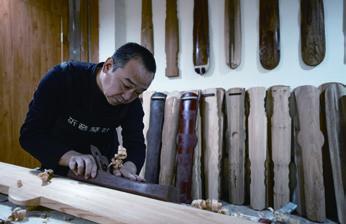Timeless Rhapsody
By Li Qing
In 1977, when NASA sent its Voyager 2 spacecraft on an exploration of outer space, it carried an unusual item. There were two phonograph records on board as mementos of Earth. One of the longest tracks the records included was Liu Shui (Flowing Streams), a classic composition on the guqin, the traditional Chinese seven-stringed musical instrument shaped like the zither, but with a much longer history.
The composition represented the transformation of a trickling stream into a powerful waterfall. The idea was communication through music.
It was recommended by Chou Wenchung, a composer and professor at Columbia Universitys Department of Music. Chou thought it was an apt representation of China, refl ecting Chinese philosophy about humans and nature. The guqin has a special place in cultural history, dating back over 3,000 years.

Despite its antiquity, more people are becoming interested in the venerable instrument today, giving it a new lease of life and modernizing guqin music. It is also being promoted as a Chinese traditional culture.
Movers and shakers
A guqin studio called Zide has a role in popularizing the instrument in recent times. Its videos of Chinese traditional music, consisting of several instruments including the guqin, have become popular on the Internet. What makes them stand out is the period costumes worn by the players, as well as the style, making them look like classic Chinese paintings come alive.
The studio was set up in 2014 by three people in their 20s in Shanghai. All three played the guqin, then began teaching others and since 2015, began making guqin videos of mainly solo performances. They also made a series of microfi lms to teach how to play the instrument correctly.
Then they started to create special chamber music, music played by a small group of instruments, usually four to six. In addition to the guqin, the other traditional instruments were the guzheng or the Chinese zither, the pipa, a four-stringed lute, and the dizi, a bamboo fl ute. In some cases, they also used foreign instruments like the udu, an African drum.
Tang Bin, artistic director of the studio and one of its co-founders, has been playing the guqin for 15 years. He developed an interest when he saw the guqin played in his favorite kungfu fi lm in senior high school.
“Each traditional Chinese musical instrument has a unique characteristic. So I pick only one of each kind in a piece of music and make them show their full potential,” he told Beijing Review.
Since 2017, the studio has been working with costumiers specializing in historical clothing as well as makeup and hairstyles. This element adds to the videos attraction to young generations.
Kongshan Niaoyu (Birdsong in Hollow Valley), is the fi rst video born of this collaboration. The costumes in it follow the style of the Song Dynasty (960-1279), characterized by flowers pinned to mens hair or caps. The melody evokes the image of a mist deep in the mountains and birds singing and is a feast for both the eye and ear. These videos generally take at least 20 days to make, from the arrangement to the fi nal presentation.
The collaboration has been a big success on Bilibili, a video-sharing platform website especially popular among young people in China.“It is hard to imagine that an ancient instrument like the guqin can attract over 460,000 followers on a website where the average age of visitors is 13,” Tang said.
The videos have also become a hit on YouTube, with the most popular one watched over 13 million times. One of the viewers, Anna Cardoso from Brazil, commented, “I love Chinese culture and music! Hope people preserve their history and dont let it die!” There are also explanatory comments by solicitous viewers explaining the cultural background or elements for foreigners, which helps them to know China.
“This shows that good music and beautiful works of art can break the boundary of nationality,” Zhu Liyue, head of the studio and another co-founder, said. He said the combination of the exquisite clothes and images can dispel foreigners stereotypes about culture in ancient China.
“There are so many elements showcasing our traditional aesthetics, such as classical dance, which can be used in our next videos,”he said.
Adapting to pop music
In addition to traditional compositions, the team also plays popular songs.
The criterion for selecting the music is that it has to be fl exible enough for the guqin. One successful experiment is a song from The Longest Day in Changan, a popular Chinese TV drama from last year. The action takes place in flourishing Changan, the largest city in the world and the capital of the Tang Dynasty (618-907), where diverse cultures integrated.
After watching the drama, Tang rearranged the song into a suite, a collection of short pieces, titled Fantasia: Changan in Ancient China. He added parts to indicate the conflict and exotic melody to denote life in the ancient city.
Because of some factors such as its low volume, the guqin may not be the most popular instrument in an ensemble. But Zhu thinks new compositions are necessary because they allow the guqin to work with other instruments.
“This mode can enrich guqin compositions and enhance its coordination ability,” he said.
In ancient times, the guqin was played by noblemen and intellectuals, representing high culture as the most elegant musical instrument. It was not intended for public performances or ensembles.
But the studios innovation makes players reform their techniques to ensure coordination with other instruments and to play pop music as well. This also makes the performances more diffi cult, Dai Xiaolian, a guqin professor at Shanghai Conservatory of Music, told Shanghai Daily.
Tang laments many players lack of ability to utilize the guqins potential as an instrument that can also play modern music. He said they perform only ancient compositions and refuse to change, which is an obstacle for the guqin becoming modern and popular. While records indicate about 3,000 compositions were handed down, only around 60 can be played.
“Only innovation can make the guqin alive in the new era,” he said, adding that this is what young players should strive for.
Traditionalists worry that these changes will damage the guqins tradition, which has been shaped by profound history, but Dai does not agree. She thinks innovations, if they are created based on solid skills and comprehen- sive understanding of the instrument, can be of high quality and become classics themselves.
Strength of youth
In the 1950s, the Chinese National Academy of Arts carried out a nationwide field research about the state of the guqin. The result showed that there were less than 100 guqin players in a population of nearly 600 million people, Tian Qing, a researcher at the institution, told news portal Ifeng.com.
Fortunately, fresh interest in guqin music was created in 2003 when it was recognized by UNESCO as one of the masterpieces of the Oral and Intangible Heritage of Humanity. Five years later, a program on the instrument shown at the dazzling opening ceremony of the Beijing 2008 Olympic Summer Games ignited considerable enthusiasm in learning to play the guqin.
Tian said nearly 200,000 guqins are put on the market annually, the largest scale ever for the instrument. Another change is that while in the past only seniors played the guqin, today the majority of learners are young people, according to Zhu.
“Young people in China have listened to all kinds of music such as pop and Western classical, and fi nally found the beauty of the guqin,”Tian said. He thinks this is the bond between the Chinese and the national traditional culture.
Tang wants to create more and better guqin pieces, especially for children so that the development of the genre can be accelerated.
“But it needs the efforts of generations,” he said.

